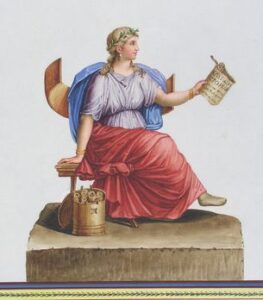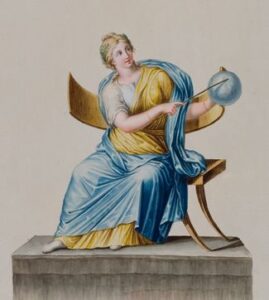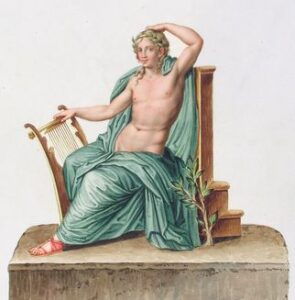di Jerzy MIZIOLEK
‘Just as the traveller wandering along the excavated streets of Pompeii discovers the remains of the houses of Cicero, Sallust, and Diomedes, so too, as we stroll along the streets of our own cities and towns, we cannot but discover the secrets of past times.’[1]
This quotation, from Leon Potocki’s beautiful, if slightly exalted book on the Czartoryski-Potocki Palace, located in the heart of Warsaw, was published in 1854 and reissued seven years later. Interestingly enough, until the Second World War, the palace contained beautiful wall decorations dating from the end of the 18th-century inspired by paintings that had been discovered some forty years earlier in the so-called Villa of Cicero at Pompeii. Similar decorations, dating from the same period or slightly later, also appeared in other buildings close to it. Fortunately a sufficient number have survived to this day, even if they have been partially restored. I have already dealt in some publications with the impact of the art of the towns of Vesuvius on Polish visual culture at the turn of the 18th century.[2] In this paper I shall be concentrating only on its impact regarding Warsaw and will deal mostly with adaptations or assimilations of the paintings which were found in the Villa of Cicero and in the Praedia of Julia Felix. The dancing Maenads from the former received the highest praise from Winckelmann, while Apollo with the Muses from the latter were given as a gift to Napoleon and his wife Josephine.[3] Both sets of images were immensely popular for many decades.[4]
The fascination with archaeological findings in the towns of Vesuvius among Poles
August Fryderyk Moszyński (1731–1786), born and educated in Dresden, was most probably the first Polish traveller to see the excavations in Herculaneum.[5] He was seventeen when he embarked on his Grand Tour in 1747/1748 which he later records with nostalgia in the diary of his second visit to Italy in the years 1785–1786. During his first visit he witnessed the very difficult dig being carried out in the theatre, and he saw some sculptures and paintings that had been discovered. Like Winckelmann he was very critical of how the excavations were being conducted. Thanks to King Stanisław August Poniatowski, Moszyński returned to Naples and the towns of Vesuvius almost forty years later. In one of his letters to the monarch he informs him about items that were soon to be sent to him:
‘Un grand bas relief, d’autres petites urnes à inscriptions, un chapiteau de l’avantscène du théâtre de Herculaneum, un beau fragment de Pompei, toute aquis à la suer de mon front et par voies illegitimes chez le vulgaire, mais très legitimment pour un antiquaire. Une petite collection de produits volcaniques ramassés à mon voyage de Vesuve et peut être quelque… antique feroit une autre caisse, mais ce ne sera pas si tôt…’[6]
By 1764, the year of his election to the throne of the Polish-Lithuanian Commonwealth, Stanisław August Poniatowski (1732–1795) had long been a connoisseur of the ideas of the Enlightenment – his collection contained numerous works of art and valuable books and drawings.[7] Among these items were the first volumes of Le Antichità di Ercolano esposte. The Central Archives of Historical Records in Warsaw holds a letter dated 17 August 1762 from Bernardo Tanucci, the powerful minister of the King of Naples – Ferdinand IV – concerning this gift.[8] The purchase of subsequent volumes of this work must have continued over the years. There is a letter dated 3 January 1786 sent by Moszyński from Naples to the king:
‘I have not had Your Majesty’s reply concerning the collection of drawings from Herculaneum. I know for certain that the last ones are not available, as a prohibition on their sale has been imposed pending elucidation which it is believed no-one here will manage to complete; so there has been no progress made with the work, neither will it be published within the next decade, but with a certain amount of effort, despite the huge obstacles, one may acquire loose pages with plates. It is not much, so if I do not receive an answer from Your Majesty before my departure, I shall purchase them at my own expense, and later Your Majesty may have them, or I shall sell them in Rome.’[9]
It is quite possible that the large volume, entitled Dessins enluminés des peintures trouvées à Herculanum, containing thirty-eight colour plates, which was once in the royal collection and in 1818 was purchased for the University of Warsaw’s School of Fine Arts (now in the Print Room of the University of Warsaw Library; Zb. Król. T. 513), was originally part of Moszyński’s purchase.[10] The said plates include, among others, The Dancing Maenads and Apollo with Muses found in the two aforementioned Pompeian houses. The Polish historian Julian Ursyn Niemcewicz recorded the king’s predilection for the collection which he was building up so assiduously, and noted that often, when the monarch returned to his residence at a late hour, after disrobing he would have a volume of copperplate prints brought to him, through which he would browse, until finally he would be found asleep with his head resting on them.[11]
The king had great enthusiasm for the art uncovered in the city of Vesuvius. One day, upon seeing Tommaso Piroli’s etchings – made on the basis of Friedrich Rehberg’s drawings, depicting Emma Hamilton’s famous ‘attitudes’ or pantomimes – in the library of one of his cousins, he immediately ordered three copies of them from Ferdynand Pinck, his court artist.[12] One set – containing 13 drawings – is preserved in the Print Room of the University of Warsaw (Zbiór Król. T. 174).[13] Pelagia Sapieha, née Potocka must have been familiar with Pinck’s copies, or with the originals by Piroli because, in 1794, she (or perhaps her husband) commissioned Elisabeth Vigée Le Brun to paint her portrait against the backdrop of a volcano which, however, appears to be Etna rather than Vesuvius (fig. 1).[14]

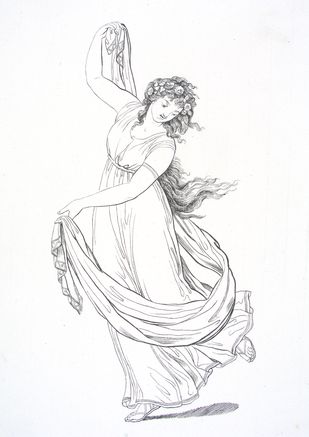
The composition – with the characteristic gesture of the arms and the wind-blown scarf – clearly reflect one of Emma’s ‘attitudes’ which in turn is patterned on the poses of the dancing Maenads from the Villa of Cicero (fig. 2).
However, in this case we are dealing with an instance of assimilation and not a simple imitation of models borrowed from Le Antichità di Ercolano esposte. The painting belongs to a group of several portraits by Vigée Le Brun that share certain similarities with regard to composition and convention. Perhaps the closest analogy is to be found in the portrait of Princess Karoline Engleberte von Liechtenstein depicted as Iris.[15]
An interesting combination of themes and decorative motifs taken from a variety of sources ‑ including the murals uncovered in Herculaneum ‑ is to be found in the paper reconstruction of Pliny the Younger’s Villa at Laurentum commissioned by Count Stanisław Kostka Potocki in 1777.[16] The case in point is the decoration of the villa’s cenatio where the scene depicting the Centaur Chiron and Achilles was adapted from a painting found in the so-called basilica at Herculaneum.[17] Even if the poses of both protagonists differ somewhat from the original, there is no doubt that the scene was patterned on one of the etchings in the first volume of Le Antichità or on a colour version of it like the one to be found in Vol. 513, housed in the Print Room of the University of Warsaw Library.[18]
In turn, the figure shown on the left of the Centaur Chiron and Achilles undoubtedly recalls the ecstatic Bacchic satyr with a thyrsus in hand on an ancient cameo, which was also known at that time from etchings,[19] whereas the motif of the two boys riding a goat, depicted on the second drawing from the set under discussion, derives from one of the murals in the Domus Aurea.[20] Therefore, in the Notes and Ideas on Pliny’s Villa, Potocki could indeed say:
‘Herculaneum, Pompeii, the Bay of Naples […] the Baths of Titus […] were of no small aid in the choice of ancient paintings, ornaments, and mosaics [for my restitution of the Laurentina].’[21]
It is worth mentioning that at the Royal Łazienki in Warsaw (King Stanisław August’s summer residence), near the Palace on the Isle, is a theatre known as the amphitheatre, which was modelled on that in Herculaneum.[22] Both the king and Johann Christian Kammsetzer, the architect who designed the project, knew the ancient model thanks to Piranesi’s engravings. However, the architect interpreted the model quite freely adapting it for musical events. The most original solution is the separation by water of the audience (cavea) from the stage filled with artificial ruins. The theatre at Herculaneum is mentioned not only in Moszyński’s letter to the king but also in the diary of Stanisław Poniatowski, the king’s nephew, who, on 20 September, noted:
‘J’ai passé ensuite à Monsieur Vega qui ainsi que toute la famille sont Romains quoique depuit 20 ans attachés au service de Naples et particulièrement à l’excavation de Herculanum… Il m’a fait voir de très beaux desseins du théâtre d’Herculanum. Cela doit avoir fourni dans son temps un édifice de bon goût et ces desseins sont agréable et curieux à voir. Il m’en a fait voir diverses autres de décorations en peintures arabesques d’un goût très agréable…’[23]
Pompeian inspirations at the Czartoryski-Potocki Palace
This account of the Czartoryski-Potocki Palace began with a quotation from Leon Potocki’s book, in which he mentions Pompeii and even the Villa of Cicero. This shall now be supplemented with references from the memoirs of Edward Dembowski, a contemporary of Potocki, and remarks on Pompeian motifs in the palace’s decoration and the cultural life within its walls. The palace, built in the first half of the 18th-century, was adorned with new interiors in the 1780s commissioned by its owner Princess Elżbieta Lubomirska aided by her son-in-law, Count Potocki. Johann Christian Kamsetzer (1753–1795), is believed to have worked on them – making the decoration for the vestibule and the Arabesque Room. This was the room with the Pompeian motifs, such as the famous Centaurs with Bacchants Playing Cymbals or Lyre, excavated in the Villa of Cicero and disseminated through various prints. Unfortunately all the decorations in the palace were destroyed by the Germans during the Second World War and are known only from photographs.[24] Coloured illustrations, including those of Centaurs and Centaurids, were in the possession of King Stanisław August Poniatowski. Moreover the famous multi-volume Le Antichità di Ercolano esposte was in the holdings of the Warsaw library of the princess’s brother, Adam Kazimierz Czartoryski. Stanisław Kostka Potocki, who visited Pompeii several times, may have influenced the selection of the Pompeian motifs. In the mid-1780s he went on another expedition to Naples, this time with his mother-in-law, who later had an exquisite Pompeian room arranged in her residence at Łańcut Castle.[25]
Leon Dembowski’s memoirs contain the following remark on the fashion for Pompeian motifs and the Empire style elaborated after 1804:
‘The French language and French dancing had become ubiquitous. A vogue set in for lunches at five o’clock and dejeuners à la fourchette, previously unknown in Poland. Even the French cuisine was eclipsing Polish traditional fare […]. In furnishings Grecian and Roman paraphernalia became even more widespread than ever. Tables, chairs, desks, and chaise-longues just could not do without eagles, lion’s paws, and the like; and tripod legs became indispensable for tables. Herculaneum and Pompeii supplied the patterns and models for everything.’[26]
These patterns also appeared in the everyday life of the palace when the so-called tableaux vivants became fashionable.
Neither marching armies and preparations for the confrontation with Russia in 1812, nor the huge expenses on the army attenuated the aristocracy’s demand for social life and entertainment. Many of the houses in Warsaw put on concerts or theatrical performances, or applied the assiduity befitting grand archaeological discoveries to stage les tableaux vivants, ‘live pictures’ – re-enactments of famous paintings or of the ancient frescoes discovered at Pompeii and Herculaneum. The vogue for such tableaux was long-lived and widely disseminated. We know that such events were held in the apartment of the Chopin family in one of the buildings of the University of Warsaw.[27] A similar cultural event organised by Countess Aleksandra Potocka, wife of Count Stanisław Kostka Potocki, was held in 1808 at the Czartoryski-Potocki Palace. To some degree it may have been inspired by Emma Hamilton’s Attitudes which were also well-known in Warsaw.
A passage from Dembowski’s memoirs reads:
‘Yesterday at Mrs. Potocka’s nous avons arrangé des tableaux. Laura [Potocka] and I arranged all the props and did the directions, and it was all a big success. We had a gallery of six living tableaux. First there was une femme de Rubens, performed by Mrs Potocka, the wife of Antoni (later Branicka). Next there was a reclining Bacchante holding a bunch of grapes and spied on by a little Satyr peeping from behind some flowers; it was played by Mrs Potocka, the wife of Aleksander, with Ludwik Kicki as the Satyr. The third picture was Domenichini’s Sybil, played by Mrs Sobolewska. Unfortunately she was dressed inappropriately, with a mix of too many colours, which made her costume gaudy. Next Mr Antoni Potocki portrayed a Van Dyck and he looked marvellous. Then there was une discussion de Carace, presented by Ewusia (Miss Kicka) and Mr Michał Grabowski, and it was the finest performance. The room was arranged with each tableau separated off by live statues: Lorcia en danseuse d’Herculanum, Mrs Gabryela Zabiełłowa née Gutakowska en Psyché, myself en Vestale, and Miss Teresa Kicka répresentait une femme faisant danser le Cupidon. The rest of the room was decorated with antique vases, candelabras, and diverse artistic knick-knacks. The event was put on for the Frenchmen. Ils paraissaient enchantés, and were probably being polite when they said that even in Paris there was nothing as beautiful as our performance. After the tableaux dinner was served and the company, which had been put in a good mood, enjoyed the rest of the evening dressing up in a variety of costumes.’[28]
We know of similar tableaux vivants from other sources as well, for instance from Antoni Brodowski’s watercolour intended as the never implemented design for a decoration of the gala rooms or ballrooms in the National Theatre (see below), and a canvas painted by Jan Rustem around 1810, now in the National Museum in Warsaw (fig. 3).
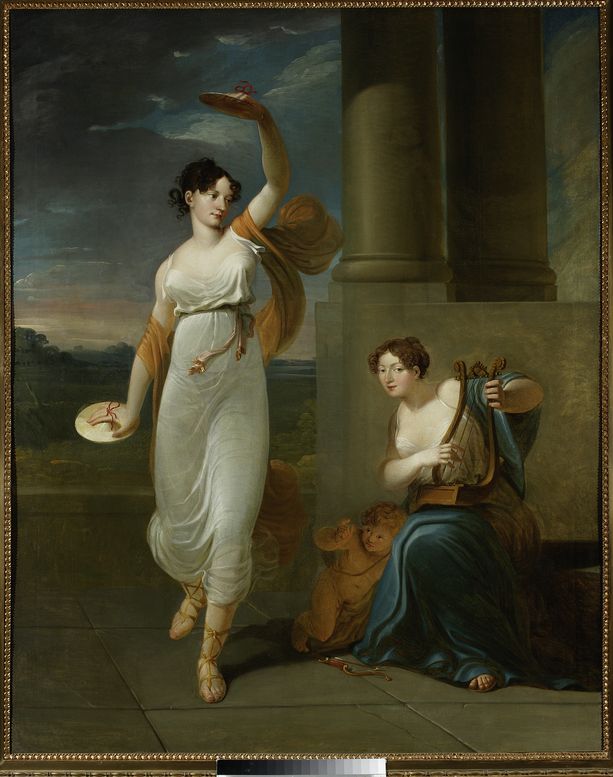
With Armenian roots and associated with Vilnius and its university, Jan Rustem received his education in art in Warsaw, tutored by Jean-Pierre Norblin de La Gourdaine and subsequently by Marcello Bacciarelli in what was known as the School of Painting at the Royal Castle.[29] He could well have seen the beautiful Maenad with Cymbals (fig. 4) and other colour prints in the king’s collection depicting paintings from Herculaneum and Pompeii.
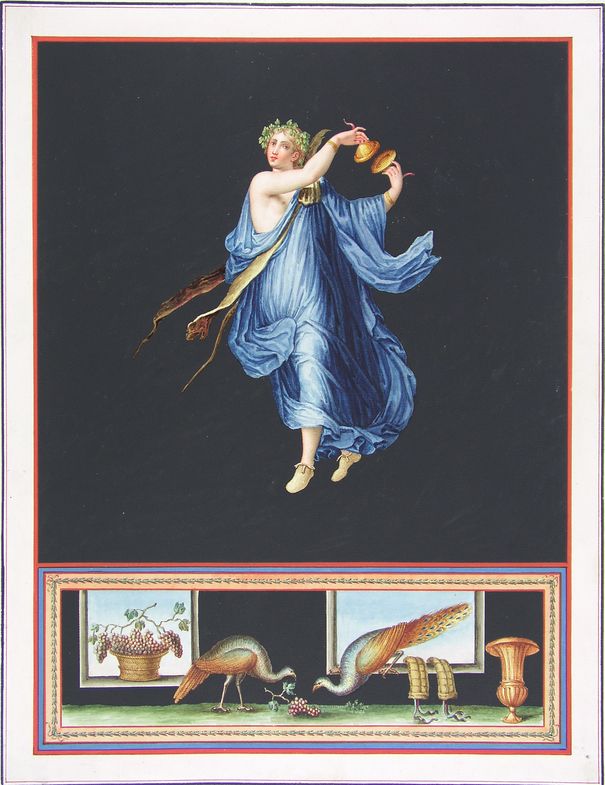
These were the works, along with tableaux vivants such as Lorcia en Danseuse d’Herculanum, in which Lorcia (presumably Laura Potocka) appeared as a dancer from Herculaneum, which inspired him to paint the portraits of Maria Mirska, Barbara Szumska, and Adam Napoleon Mirski.
In this painting the central figure is Maria Mirska, presented as a dancer with cymbals in her hands. Her pose may, on the one hand, be seen as a forerunner of the dancer in Brodowski’s design and, on the other, as a visual embodiment of the dancer described in Dembowski’s memoirs. As we have seen and as Dembowski’s reminiscences tell us, tableaux vivants were popular in Warsaw at the time, and Rustem was often asked to stage them. In an age when practically everyone was interested in the excavations carried out in Vesuvian towns, the reception of the art of Antiquity was being promoted not only directly by ancient works of art, but also by performances of this kind, which were inspired by ancient artworks. The performances given in the Czartoryski-Potocki Palace were in perfect harmony with the Neo-Pompeian decoration of the superb Arabesque Room. This fashion was still alive in the 1820s when the new National Theatre, designed by the Italian architect, Antonio Corazzi, born at Livorno and educated in Florence, was being constructed next to the palace (fig. 5).[30]
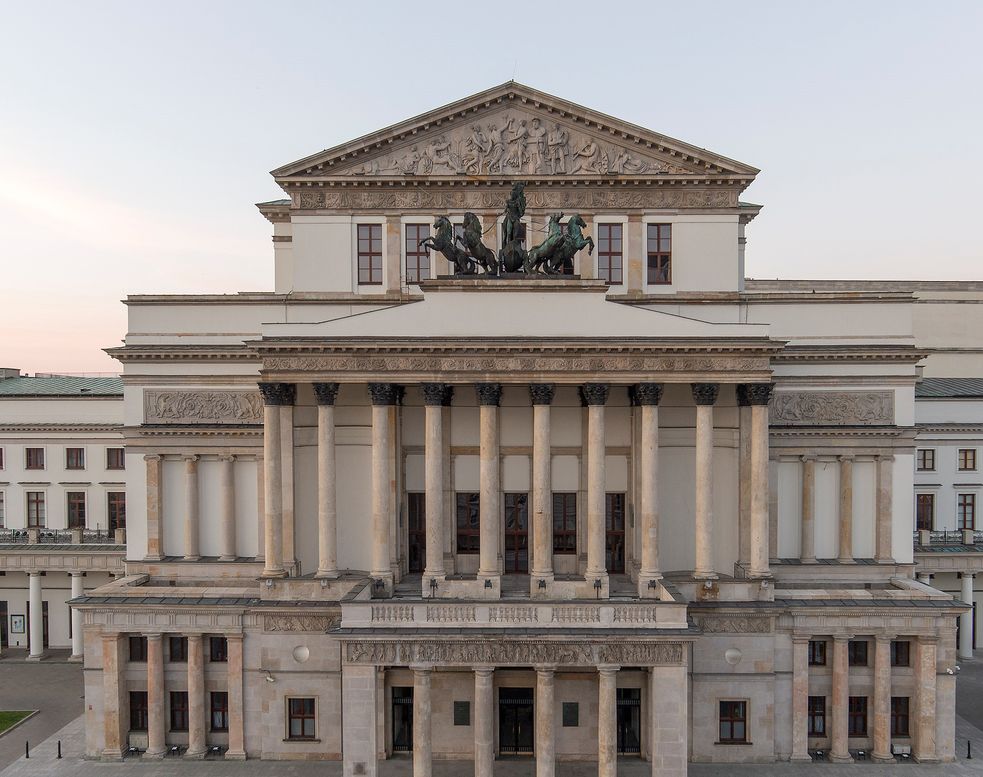
The Pompeian Dancers in the National Theatre
On 1 December 1825 – therefore shortly after the laying of the foundation stone of the new Theatre – an exceptional document was produced: a now all but forgotten letter,[31] addressed to a government committee, in which a group of artists – professors of the Fine Arts Department of Warsaw University, created between 1809 and 1817 – called for commissions with regard to the decoration of the facade and interiors of the theatre:
‘The newly established National Theatre opens up vistas for many artists to show their suitability and desire to serve the country with excellent work. The painting of plafonds, curtains and other embellishments; many sculpted adornments and statues are a worthy object of emulation for domestic artists. […] According to news that reaches us, the government’s builder Corazzi is travelling to Italy in order to bring back his relatives [or friends] for theatre paintings and sculptures in a [very] beneficial [for him] arrangement. If the government doubts the ability of domestic artists, let a competition be announced either for every single object of painted or sculpted decoration or for paintings and sculptures, to which foreigners might also be admitted, be it only to ensure that a compatriot who produces a competition piece better or as well as a foreigner will receive priority before him. […] In that way, perhaps with time the nucleus of a truly national school in the fine arts would be formed, one that would train only those inspired by the national spirit.’[32]
A reply was given on 29 March 1826; the battle for contracts for university professors and their pupils, and also for the craftsmen of Warsaw, was won, albeit only in part. Some of the commissions went to local artists and craftsmen, but Italian artists were not ruled out.[33] In the years 1826–1829, numerous artists and craftsmen received commissions; among them Antoni Brodowski and Paweł Maliński, both professors of the Fine Arts Department of Warsaw University, and Konstanty Hegel, one of the sculptors trained in that department. Brodowski was to adorn the walls of the ballrooms with all’antica decorations; he made his beautiful neo-Pompeian project already in 1826, but it never came to fruition, as will be discussed later. Maliński was to produce
‘a bas-relief on the bottom band of the peristyle in the place of a Doric cornice above three arcades at the front, depicting the return of Oedipus and people from the Olympic Games according to Sophocles.’
That relief was to show sixty figures. The contract with Hegel concerned among others
‘four geniuses above the entrance gates of colossal proportions to two different models and two [Pompeian] dancer-bacchantes next to the peristyle. Tomaso Accardi (Acciardi), the Italian sculptor, undertook to produce a ‘bas-relief for the tympanum representing a bust of Anacreon on a base adorned with festoons; around this, assembled herdsmen play and sing together, and the bust is hung about by three dancing nymphs with laurels of oak and olive leaves. This scene should comprise nine figures entirely en relief and a bust of Anacreon, with the rest filled with instruments and other suitable embellishments’[34].
Ludwik Osiński, a long-serving director of the National Theatre, and professor of literature at the University of Warsaw, may have had considerable influence on the choice of Anacreon (slightly strange to people of our times) to hold such a prominent place in the programme of the Theatre’s decorations. He may have put in the mind of the Italian sculptor one of Anacreon’s works, which reads:
‘Lord, with whom Love the subduer and the blue-eyed Nymphs and radiant Aphrodite play, as you haunt the lofty mountain peaks, I beseech you: come to me with kindly heart, hear my prayer and find it acceptable: give Cleobulus good counsel, Dionysus, that he accept my love!’[35]
The herdsmen, nymphs and above all Dionysus form a ‘theatrical circle’. Around the turn of the fifth century BCE, and so in the times of Anacreon, who travelled to Athens from Teon, one of the phenomena of Greek culture was born: the theatrical show, tragedy and comedy. In Acciardi’s tympanum, Anacreon is shown in the midst of numerous motifs connected with the theatre. So at this point, some attention should be devoted to other elements of the facade’s decoration; taken together, they make up a programme referring to forms, signs and ideas. Ferrante Marconi produced the frieze beneath the tympanum, on which lyres and festoons with flowers and fruit are represented, with nine visible theatrical masks bearingdifferent exp ressions. It is known that masks, which appear in several other places on the facade, are among the most important props of Greek and Roman theatres. Among the instruments depicted, are four kinds of lyres and a syrinx (also known as the Pan pipes) with a tambourine.
Marconi also produced the frieze above the peristyle, embellished with beautifully serrated acanthus leaves, and the four bas-reliefs on either side of the peristyle, above the windows with pilasters and Ionic columns, created in two versions. Represented on each of these are griffins in an antithetical relation. In one of the variants, which appears twice, they are facing each other and resting their feet on a centrally positioned lyre; in the other, the centrepiece of the composition comprises a beautiful acanthus motif with intricate leafy scrolls on either side, whilst the mythical creatures are placed on the edges, facing away from each other and touching massive lyres with their feet. It is likely that the griffin, that lion-eagle, was chosen not only for decorative reasons, but also because this mythological hybrid is associated with Apollo. According to some sources, griffins also guarded Dionysus’ full cup. Thus the Dionysian motifs and the Apollonian elements (griffin, lyres and other instruments) are interwoven.
As already mentioned, the contract with Konstanty Hegel was for
‘four geniuses above the entrance gates of colossal proportions […] two dancer-bacchantes […] three masks on the keystones in the front arcades beneath the peristyle.’
The commission was fulfilled, but unfortunately nearly all those motifs were recast after the war. Luckily, the originals were recreated very faithfully, including the laurels and other props in the geniuses’ hands. The dancing bacchantes shown on the side walls of the peristyle were among the obligatory characters in Dionysus’ retinue. Both are dressed in ethereal attire and shown in a frenzied dance, with their arms raised; one is playing a tambourine, the other is making music with cymbals (figs. 6, 8).
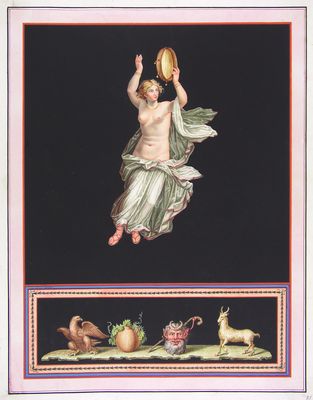
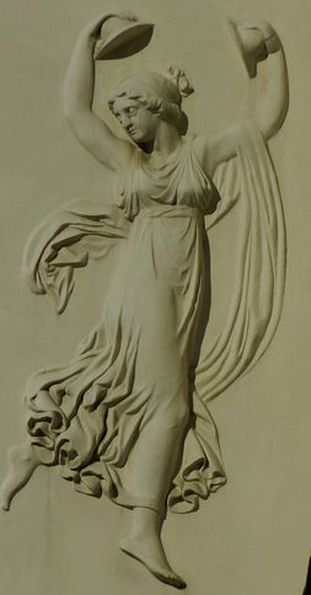 Hegel may have known the album entitled Desseins enluminés des peintures trouvées à Herculanum well. It contains, among other things, two watercolours depicting maenads, one of which is dancing with a tambourine and the other with cymbals. The originals were found in Cicero’s Villa.[36]
Hegel may have known the album entitled Desseins enluminés des peintures trouvées à Herculanum well. It contains, among other things, two watercolours depicting maenads, one of which is dancing with a tambourine and the other with cymbals. The originals were found in Cicero’s Villa.[36]
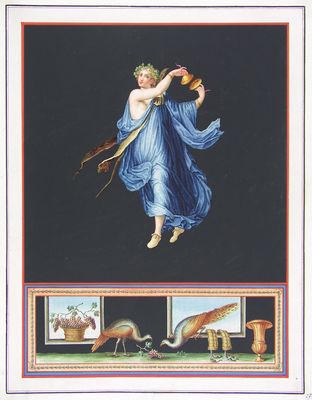
The first is an almost exact replica of the ancient model, although, here in Warsaw – as if with the climate in mind – it was deprived of its charming semi-nakedness. The Dancer with cymbals is an adaptation of sorts of the Pompeian painting; the sculptor could have taken his inspiration from another model.
The Pompeian Dancing Maenads also fascinated Antonio Canova, who not only sculpted them (fig. 9), but also painted them, as was shown in an interesting exhibition held in 2012.[37] His beautiful and airy artistic creations were immediately copied in drawings, occasionally with minor modifications, and also engraved (fig. 10).
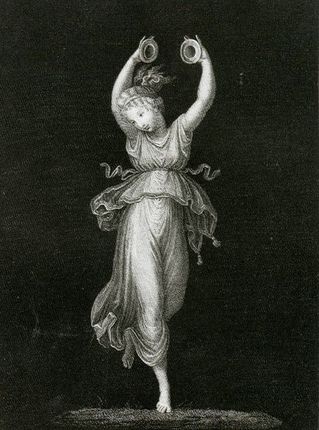
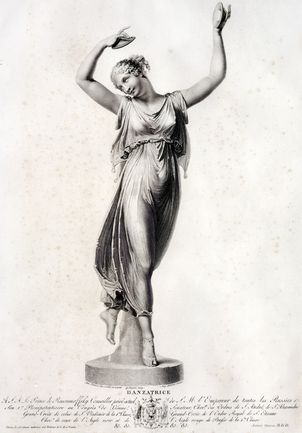
The engravings travelled all over Europe inspiring artists and craftsmen. It seems highly likely that one such print, from 1814, showing Canova’s work produced two years earlier, came into the hands of Hegel who was in touch with numerous Italian artists active in Warsaw, particularly with those who were employed at the National Theatre. A mere glance at Angelo Bertini’s engraving of a drawing by Giovanni Tognoli is enough to realise where the Warsaw artist could have found the model for his Dancer.
A Dionysian element also appears in the hand of one of the four geniuses (all those airy figures are based partly on Roman Victorias, familiar from triumphal arches, such as the arches of Septimius Severus and Constantine the Great, and partly on Pompeian murals) above the old entrance gate. That element is a thyrsus, and so a cone – a symbol of new life and rebirth – fixed on a long shaft. It is the thyrsus and the dancing maenads – the ballerinas with cymbals and tambourine/drum – that lead us to the exquisite design for the decoration of the Ballrooms, which never came to fruition.
An abandoned design for the painted decoration of the Ballroom
This design is a watercolour on paper measuring 50.8 x 37.5 cm with the inscription ‘Design for paintings on the walls of the main Ballroom’ and the signature ‘Ant. Brodowski’, held in the National Museum in Warsaw. The bottom of the left-hand pilaster shown on the watercolour also bears the date: 1826 (fig. 11).

We can only regret that only this one watercolour has come down to us of the entire cycle of Brodowski’s designs. Yet it does give a good idea of the artistic standard of the planned decorations of the interior of the National Theatre.
There is a report on those decorations in Gazeta Lwowska (issue no. 46 of November 1829, p. 375):
‘Besides details of the main body, we should also say something about the pavilions, which contain various parts for the comfort and convenience of the theatre and the audience. The most splendid of these is the grand Ballroom and the adjoining [ballrooms], which are perfectly connected to the theatre and are to be adorned with colonnades and beautiful paintings by the most renowned masters of our capital.’ According to some scholars, the fresco designed by Brodowski was to be placed on the side wall of the main hall, separated from the adjoining ballrooms by columns.[38]
Brodowski’s beautiful watercolour has the form of a triptych flanked by pilasters with Ionic capitals; they are equally as refined as the capitals on the facade of the National Theatre. The left wing of this triptych shows the slender silhouette of a Maenad in a whirling dance, turned to the central scene. She is dressed in a short white chiton, a blue peplos and a red scarf. The beautiful dancer, with a wreath of green leaves on her head, is holding cymbals in her hands, one of which is raised above her head, with the is other hanging down. Her pose and gestures underscore the connection with the other two parts of the triptych; we also note, despite the differences, a similarity to the Maenads on the facade of the theatre, particularly the one with cymbals.
The bacchante represented on the right wing of Brodowski’s design is shown from the side and turned towards the centre of the composition. Dressed in a pale green robe, adorned with a wreath that rests on her head, she holds in her right hand a long staff surmounted with a cone, in which she resembles the winged genius mentioned earlier. In her left hand, which is raised up high, she wields a goblet full of grapes. The purple-pink scarf thrown over her right shoulder makes it seem that this figure is floating in the air. The Dancers on both wings of the triptych are lent a special charm by the scarf, blown by the wind, which creates a sort of ethereal arch. There is no doubt that they are inspired by the Pompeian Dancers/Bacchantes.
In the middle part of the triptych, a dancing couple is shown against a blue sky with brown-grey clouds. In a long light green robe, billowing at the bottom in the wind, with a white chiton thrown over the top, the female figure – probably Terpsichore, the muse of dance – faces to the right and appears to be rising in the air with the unconstrained movement of her bare legs, which are cast backwards. Turning her head in the opposite direction to the orientation of her torso, she holds in her left hand a lyre that rests against her breast, while the right hand seems to be striking the strings. Leaping out at an angle from behind is the similarly raised figure of a bare-footed young man in a green chiton. This curly-haired youth, spreading a red scarf out in an arc over his companion, bends his head towards her, and she also turns her face in his direction, thereby enhancing the bond of this couple, composed on the crossing diagonals of a rectangle.

This scene would appear to be inspired by one of the Pompeian murals (fig. 12) and by two frescoes from Domus aurea, published in Vestiglia delle Terme di Tito (1776); one of these shows Ariadne and Dionysus, the other Mars and Venus.[39] Yet Brodowski displayed genuine inventiveness in his design. Although we note inspirations from ancient models in all the parts of the triptych, such as Bacchante with Cymbals, on each occasion we see his own version, and so we are dealing with the creative imitation or assimilation of masterpieces that were universally admired in his day. Such models, drawn from the art of the Vesuvian towns, were – as has already been said – also accessible in Warsaw, in the form of excellent copies.
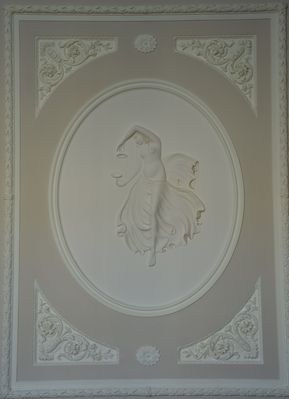
Although the watercolours (coloured prints) in Vol. 513 have only recently been published,[40] there is no doubt that they were studied many times, probably most often during the period 1818–1831. This large album bears traces of being well thumbed, particularly on the covers, dating back to the times of King Stanisaw August. It was probably used in lectures by Jan Feliks Piwarski, the first head of the Print Room, and probably by Brodowski as well. The dancer-ballerinas draw us into the mystery of Dionysian dance, and by the same stroke into the birth of theatre and ballet, present not just on Hegel’s reliefs and in Brodowski’s design, but also in Rustem’s painting dating from c.1810.
So the two Maenads-Bacchantes-Dancers on the facade of the National Theatre await a revival of Daniel Auber’s opera Muta di Portici and the implementation of Brodowski’s beautiful design on one of the walls of the Ballroom. Furthermore, some eight years ago it was discovered that dancing Maenads in the Pompeian style also adorned the ballroom of the Tyszkiewicz Palace (fig. 14).[41]

This beautiful palace erected a short distance from the Czartoryski-Potocki Palace, and next to the old campus of the University of Warsaw, was built at the end of the eighteenth-century. Almost at first glance, it is clear that its apse-like niche is in fact patterned on the famous shell in the apse of the Domus Aurea (it adorns the famous Hall of Achilles at Skyros) (fig. 15)[42].
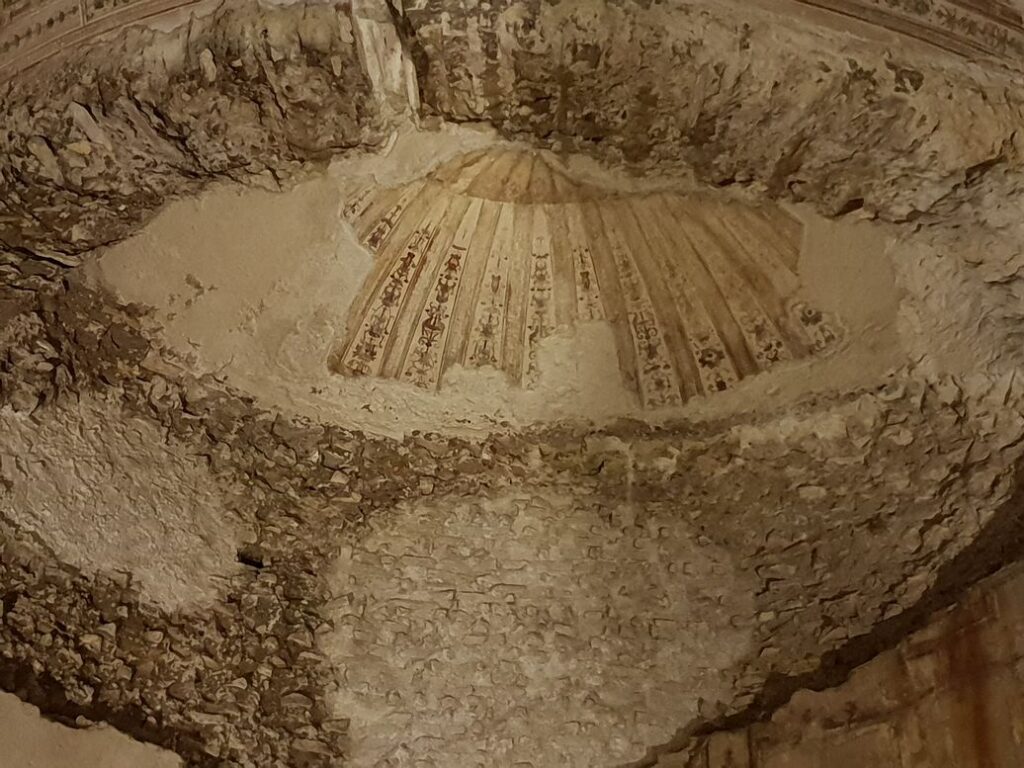
The stuccoes, most probably produced by two Italian artists – Giuseppe Amadio and Paolo Casasopra – which have been found only partially preserved (because of the fire which devastated the palace during the Second World War), have now been beautifully recreated and form an interesting pendant to the Dancers on the facade of the National Theatre.[43] Luckily enough, within the precincts of the university campus there is yet another example of inspiration taken from Dessins enluminés des peintures trouvées à Herculanum.
Apollo and the Muses on the University campus.
The main building of the University of Warsaw, with the offices of the Rector, is known as the Kazimierzowski Palace.[44] It was built in the seventeenth century and rebuilt several times. In the 1820s the two-floor building received new main facade, with a four-column portico in the Corinthian order on the main axis, crowned with a pediment or tympanum. It is filled with a figural relief featuring Apollo Among the Muses by Paweł Maliński – a work which fortunately survived the Second World War (fig. 16).
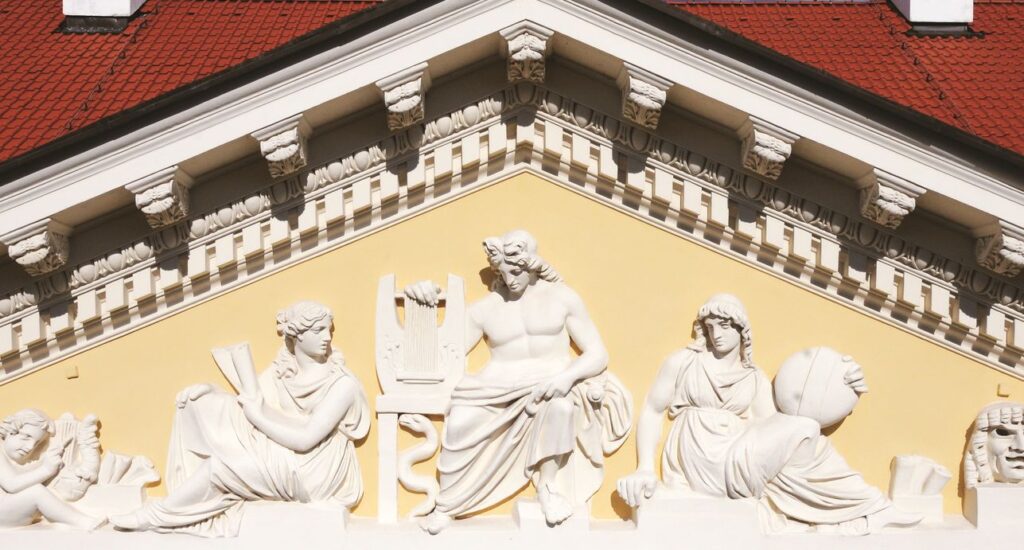
Here Apollo is shown as a long-haired youth seated on a throne, accompanied by Urania, or Astronomy, with a globe and Calliope or Clio with a scroll. A winged putto, a theatre mask and a serpent (visible under the musical instrument held by Apollo) complete the composition. The style, topic and arrangement of the tympanum, which is an interesting example of Warsaw sculpture of the first quarter of the nineteenth century, fully reflect the neoclassical ideals derived from Greco-Roman art. The tympanum was one of the most important landmarks of the university courtyard. Thus university professors and students, among them Fryderyk Chopin, lived in the realm of Apollo, the god of illumination, and leader of the Muses.
There is almost no doubt that Maliński took inspiration for his composition from Vol. 513 which derived from King Stanisław August’s collection. Since c. 1820 it has belonged to the University of Warsaw Library, which was housed in the Kazimierzowski Palace.[45] The album in question also consists of colour copies of frescoes discovered in the House of Julia Felix in Pompeii.[46] Among them are plates depicting Apollo and nine Muses including both Urania with a globe and Calliope or Clio with her scroll.[47] Maliński used the Pompeian models quite freely when was creating the tympanum (figs. 17, 18, 19). He did his best to produce a solemn composition with Apollo seated in the centre.
Interestingly enough Fryderyk Chopin, who in the years 1817–1827 could see the tympanum everyday (also from the windows of his house), refers to Apollo and Muses in some of his letters.[48] One of them to a friend, Jan Białobłocki, dated 8 January 1827 reads:
‘Perhaps you think that I spent it [the money you left with me] during the carnival at some friend’s little ball, or that I have converted the rites of Bacchus into something worthy of a son of Apollo? Mistaken notion! Low thoughts! Bosh! I have bought you two airs from Freischütz, with which you ought to be pleased.’[49] Chopin calls himself again ‘a son of Apollo’ in the context of one of his concerts in Vienna.[50] As to the Muses; he refers to Euterpe rather than to Clio or Urania; all in all Apollo and his retinue were part of the classical education he received in the building adorned with the tympanum produced by Maliński, who was Professor of sculpture in the University Department of Fine Arts.[51]
*
Here, we should add – instead of a conclusion – that the tragedy of the towns around Vesuvius and a visit to them became for many Poles of those times, i.e. c. 1800, an unforgettable memory of a lifetime and was also inscribed within the context of the difficult political situation of the Polish-Lithuanian Commonwealth at the end of the eighteenth century. In his memoirs, Niemcewicz wrote:
‘Almost half a century later [after a visit to Pompeii] when [in 1825] the travelling artist arrived in Warsaw with a panorama of interesting sites, including Pompeii, my interest in that place was so keen that I ignored the other views and sat before it for nigh on an hour […]. For me, that is one of the most interesting ancient relics. […] Why, o heavens, did I not live in Pompeii, was I not buried there? I would not have beheld the present demise of my homeland.’[52]
POSTSCRIPTUM
In 2010, while preparing my preliminary study on the impact of the arts uncovered in the towns on the visual culture in Poland I came across ‘una splendida produzione della officine editoriali Ignaz Pleyel’ consevata nella Biblioteca Musicale S. Cecilia in Rome.[53] This publication of ‘Douze nouveau Quintetti pour deux violons, deux violoncelles et alto par Luigi Boccherini’ (printed in Paris in 1798) is adorned with an interesting engraving depicting two women – one seated beneath a tree and the other descending from the sky (fig. 20).[54]
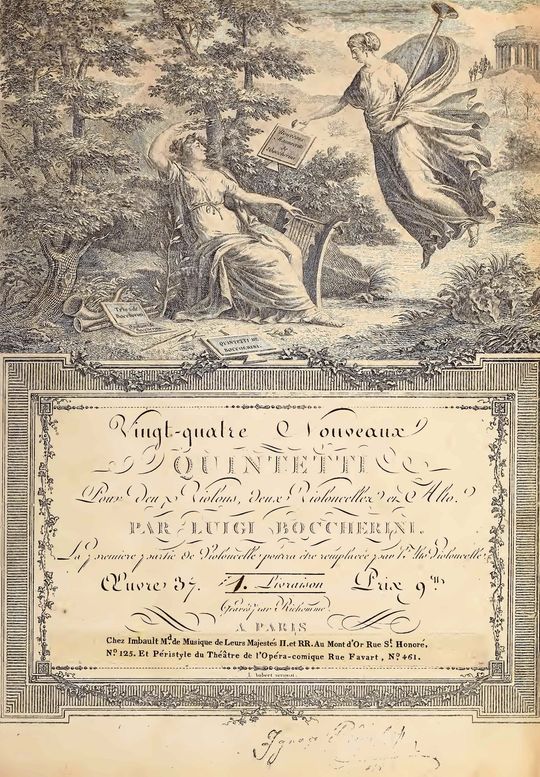
The first is modelled on the portrayal of Apollo found in the Praedia of Julia Felix, while the other is an adaptation of the dancing Maenad holding a lime branch and a golden sceptre, being gifts to Dionysus from one of his Parnassian priestesses (fig. 21).
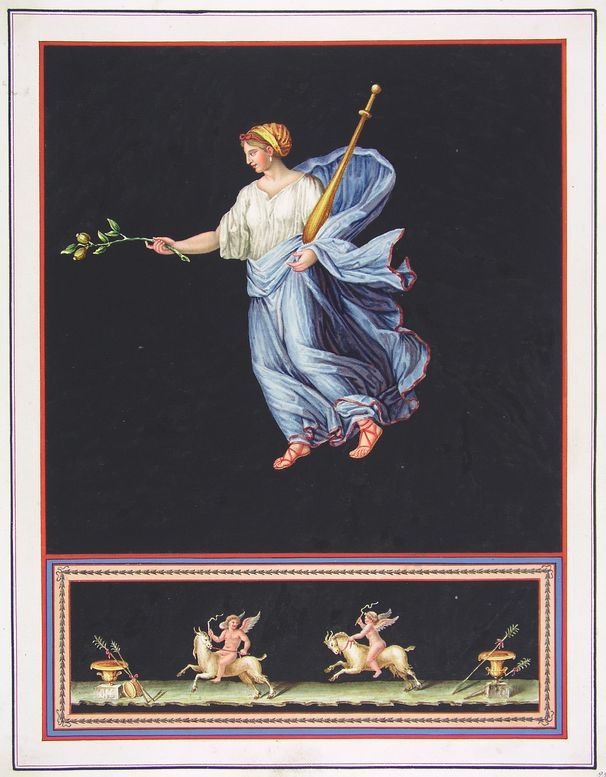
The latter image was uncovered in the Villa of Cicero; it was soon reproduced in Vol. I of Le Antichità and then both in Vol. 513 and that in the Louvre.[55] This beautiful allegoric scene connected with Boccherini deserves a separate study.
Jerzy MIZIOLEK 9 Luglio 2023
Bibliography
AJELLO et alii, 1988
R.AJELLO-F.BOLOGNA-M.GIGANTE-F.ZEVI 1988 – Le antichità di Ercolano, Napoli 1988.
Antiquity Recovered 2007
Antiquity Recovered. The Legacy of Pompeii and Herculaneum, V.C. GARDNER – J.L. SEYDL (ed.), Los Angeles 2007.
Canova e l’incisione 1993
Canova e l’incisione, exhibition catalogue, G. PEZZINI BERNINI, F. FIORANI (ed.), Bassano del Grappa (Vicenza), 1993.
Canova e la danza 2012
or
BARASSI 2012
E. BARASSI, Canova e la danza, exhibition catalogue, M. GUDERZO (ed.), Crocetta del Montello (Treviso) 2012.
BIEGAŃSKI 1968
-
BIEGAŃSKI, Antonio Corazzi (1792–1877). Architetto toscano a Varsavia, Wrocław–Warszawa–Kraków 1968.
BILIŃSKI 1982
-
BILIŃSKI, Viaggiatori illuministi polacchi sul Vesuvio e nelle città vesuviane, La regione sotterrata dal Vesuvio. Studi e prospettive. Atti del Convegno Internazionale, 11-15 novembre 1979, Napoli 1982, pp. 41-88.
BILIŃSKI 1992
-
BILIŃSKI, August Moszyński un illuminista polacco visitatore critico della Roma settecentesca (1785), in ID., Figure e momenti polacci a Roma. Strenna di commiato, Wrocław -Warszawa –Kraków 1992, pp. 174-189.
BUSIRI VICI 1971
-
BUSIRI VICI, I Poniatowski e Roma, Roma 1971.
Chopin’s Letters 1931
Fréderic Chopin’s Letters. Collected by H. OPIEŃSKI, transl., by E. L. Voynich, New York 1931.
Cinque secoli di stampa musicale 1985
Cinque secoli di stampa musicale in Europa, Catalogo della mostra, Palazzo Venezia, Roma 1985.
D’ALCONZO 2015
-
P. D’ALCONZO, Facing Antiquity, Back and Forth, in eighteenth-century Naples, in Music in Art, XL (2015), 1-2, pp. 9-43.
DEMBOWSKI 1898
-
DEMBOWSKI, Moje wspomnienia [I miei ricordi], vol. 1, Petersburg 1898.
Eye of Josephine 2007
or
DENOYELLE et alii 2007
-
DENOYELLE – S. DESCAMPS-LEQUIME, The Eye of Josephine. The Antiquities Collection of the Empress in the Musée du Louvre, Atlanta 2007.
Élisabeth Vigée Le Brun 2016
Élisabeth Vigée Le Brun and Poles, Warsaw 2016.
FABRE 1952
-
FABRE, Stanislas-Auguste Poniatowski et l’Europe des lumières, Paris 1952.
FRASER 1986
-
FRASER, Beloved Emma. The Life of Emma, Lady Hamilton, London 1986.
GARDNER et alii 2012
V.C. GARDNER – K. LAPATIN – J.L. SEYDL, The Last Days of Pompeii, Los Angeles 2012.
JACOPI 2001
-
JACOPI, Domus Aurea, Milan 2001.
KOSSECKA 1999
-
KOSSECKA, Gabinet Rycin króla Stanisława Augusta, Warszawa 1999.
MATTUSCH 2008
C.C. MATTUSCH, Pompeii and the Roman Villa, Washington 2008.
MIKOCKI 1988
-
MIKOCKI, À la recherche de l’art antique les voyageurs polonais en Italie dans les années 1750-1830, Wrocław-Warszawa 1988.
MIZIOŁEK 2010a
J.MIZIOŁEK, Muse, Baccanti e Centauri. I capolavori della pittura pompeiana e la loro fortuna in Polonia, Varsavia 2010.
MIZIOŁEK 2010b
-
MIZIOŁEK, En danceuse d’Herculanum”. Qualche osservazione sulla fortuna della pittura pompeiana in Polonia, in: Scambi e conforti, sui modi dell’arte e della cultura, tra Italia e Polonia. Esperienze significative ed occasioni di riflessione, S. NAPOLITANO, Nola 2010, pp. 155-179.
MIZIOŁEK 2015a
-
MIZIOŁEK, The Grand Theatre in Warsaw. The 250th Anniversary of Public Theatre in Poland 1765-2015,Warsaw 2015.
MIZIOŁEK 2015b
-
MIZIOŁEK, Chopin nell’ambiente dell’Università di Varsavia, [in:] Chopin e l’Italia, J. Miziołek, L. Masi (edd.), Varsavia 2015, pp. 219-254.
MIZIOŁEK 2016
-
MIZIOŁEK, The Villa of Pliny the Younger in an Eighteenth Century Vision, Rome 2016.
MIZIOŁEK 2017
-
MIZIOŁEK, The University of Warsaw. History and Traditions, Warsaw 2017.
MIZIOŁEK, KOWALSKI 2010
-
MIZIOŁEK- H. KOWALSKI, Chopin among Artists and Scholars, Warsaw 2010.
MIZIOŁEK, KOWALSKI 2014
-
MIZIOŁEK, H. KOWALSKI, Secrets of the Past. Czartoryski-Potocki Palace in Warsaw, Warsaw 2014
MIZIOŁEK, ŻELAZOWSKI 2021
-
MIZIOŁEK, J. ŻELAZOWSKI, Roma e lo stato delle arti nella descrizione del Conte August F. Moszyński del 1785, in: “Kritiche”, 2, 2021, pp. 135-173
MIZIOŁEK, ŻELAZOWSKI 2022
-
MIZIOŁEK, J. ŻELAZOWSKI, Il Campidoglio e i Musei Capitolini nel Diario del conte polacco August Fryderyk Moszyński (1785), „Bullettino della Commissione Archeologica Comunale di Roma” 123, 2022, pp. 163-185
NAJBJERG 2007
-
NAJBJERG, From Art to Archaeology. Recontextualizing the Images from the Porticus of Herculaneum, in Antiquity Recovered 2007, pp. 59-72.
NAPOLEONE et alii 2000
-
NAPOLEONE – M.-N. PINOT DE VILLECHÉNON, Ercolano e Pompei. Gli affreschi nelle illustrazioni neoclassiche dell’album delle “Peintures d’Herculanum” conservato al Louvre, Milano 2000.
NIEMCEWICZ 1880
J.U. NIEMCEWICZ, Pamiętnik czasów moich, Tarnów 1880.
NIEMCEWICZ 1957
J.U. NIEMCEWICZ, Pamiętniki czasów moich, J. DIHM (ed), vols. 1–2, Warszawa, 1957.
OTTANI CAVINA 1982
-
OTTANI CAVINA, Il Settecento e l’antico, in: Storia dell’arte italiana, parte seconda, vol. 2, Torino 1982, pp. 599-660
OTTANI CAVINA 2004
-
OTTANI CAVINA, Geometries of Silence: Three Approaches to Neoclassical Art, A. MCEWEN (trans.), New York 2004.
PARSLOW 1998
Ch. C. PARSLOW, Rediscovering Antiquity. Karl Weber and the Excavation of Herculaneum, Pompeii, and Stabiae, Cambridge 1998.
PERCY III 1996
-
A. PERCY III, Pedereasty and Pedagogy in Archaic Greece, Illinois, 1996.
PINOT DE VILLECHÉNON 2002
M.-N. PINOT DE VILLECHÉNON, Domus Aurea: La decorazione pittorica del palazzo neroniano nell’album delle „Terme di Tito” conservato al Louvre, Milano 2002
PIRANESI – FICACCI 2000
-
FICACCI, Giovanni Battista Piranesi, Köln–London 2000
POTOCKI 1854
-
POTOCKI, Święcone – czyli Pałac Potockich w Warszawie, Warszawa 1854.
RAMAGE 2013
-
H. RAMAGE, Flying Maenads and Cupids: Pompeii, Herculaneum, and Eighteenth-Century Decorative Arts, in Rediscovering the Ancient World 2013, pp. 161-176.
Rediscovering the Ancient World 2013
Rediscovering the Ancient World on the Bay of Naples, 1710-1890, C.C. MATTUSCH (ed.), New Haven and London 2013.
Rosso pompeiano 2007
Rosso pompeiano. La decorazione pittorica nelle collezioni del Museo di Napoli e a Pompei, M. L. NAVA, R. PARIS, R. FRIGGERI (edd.), (catalogo della mostra), Roma, Museo Nazionale Romano, Palazzo Massimo alle Terme, 20 dicembre 2007-31 marzo 2008, Milano 2007.
RUFFINIÈRE Du PREY 1994
-
De La RUFFINIÈRE Du PREY, The Villas of Pliny from Antiquity to Posterity, Chicago- London 1994.
SIENKIEWICZ 1930
-
SIENKIEWICZ, Projektowane dekoracje ścienne Teatru Narodowego. Kartka z dziejów ruchu artystycznego Warszawy doby Królestwa Kongresowego, „Studia do Dziejów Sztuki w Polsce”, t. 2, Warszawa 1930, pp. 65–78.
Sovrane fragilità 2007
Sovrane fragilità. Le Fabbriche Reali di Capodimonte e di Napoli, Milano 2007.
TOUCHETTE 2000
L.-A. TOUCHETTE, Sir William Hamilton’s ‘Pantomime Mistress`: Emma Hamilton and Her Attitudes, in: The Impact of Italy. The Grand Tour and Beyond, C. HORNSBY (ed.), London 2000, pp. 123-146.
WAŹBIŃSKI 1989
-
WAŹBIŃSKI, Projet de l’établissement d’une Académie Royale de Peinture et Sculpture dans la Ville de Varsovie: Contribution d’Auguste Frederic Moszyński au système d’éducation artistique en Pologne dans la seconde moitié du XVIIIe siècle, in Academies of Art between Renaissance and Romanticism, The Hague 1989, pp. 406–433.
WAŹBIŃSKI 1992
-
WAŹBIŃSKI, La Galleria di scultura di Stanislao Augusto Poniatowski a Varsavia: origine e significato, in J. HÜBNER-WOJCIECHOWSKA (ed.) L’eredità classica in Italia e Polonia nel Settecento, Wrocław–Warszawa–Kraków pp. 223-232.
WINCKELMANN 1831
-
G. WINCKELMANN, Lettera sulle scoperte di Ercolano al Sig. Conte Enrico di Brühl, in Opere di G. G. WINCKELMANN, t. VII, Prato 1831, pp. 127- 236.
ZAMOYSKI 1992
-
ZAMOYSKI, The Last King of Poland, London 1992.

